Waste from Oil Industry in India: Environmental Impact and Solutions
VerifiedAdded on 2023/06/13
|7
|1846
|346
Report
AI Summary
This report assesses the impact of oil industry waste on India's environment, focusing on air pollution, soil contamination, and threats to aquatic life. It highlights that while the oil industry contributes significantly to India's economy, its waste products cause substantial environmental damage. Air pollution results from emissions during oil production, leading to health problems and ozone layer depletion. Soil contamination, caused by oil spills and heavy metals, compromises plant and human health. Oil spills in water bodies harm aquatic life. The report suggests solutions such as updating environmental standards, promoting clean energy, applying the polluter pays principle, and using bioremediation techniques to mitigate these adverse effects, emphasizing the need for a balanced approach that prioritizes both economic benefits and environmental protection. Desklib offers more solved assignments and past papers for students.
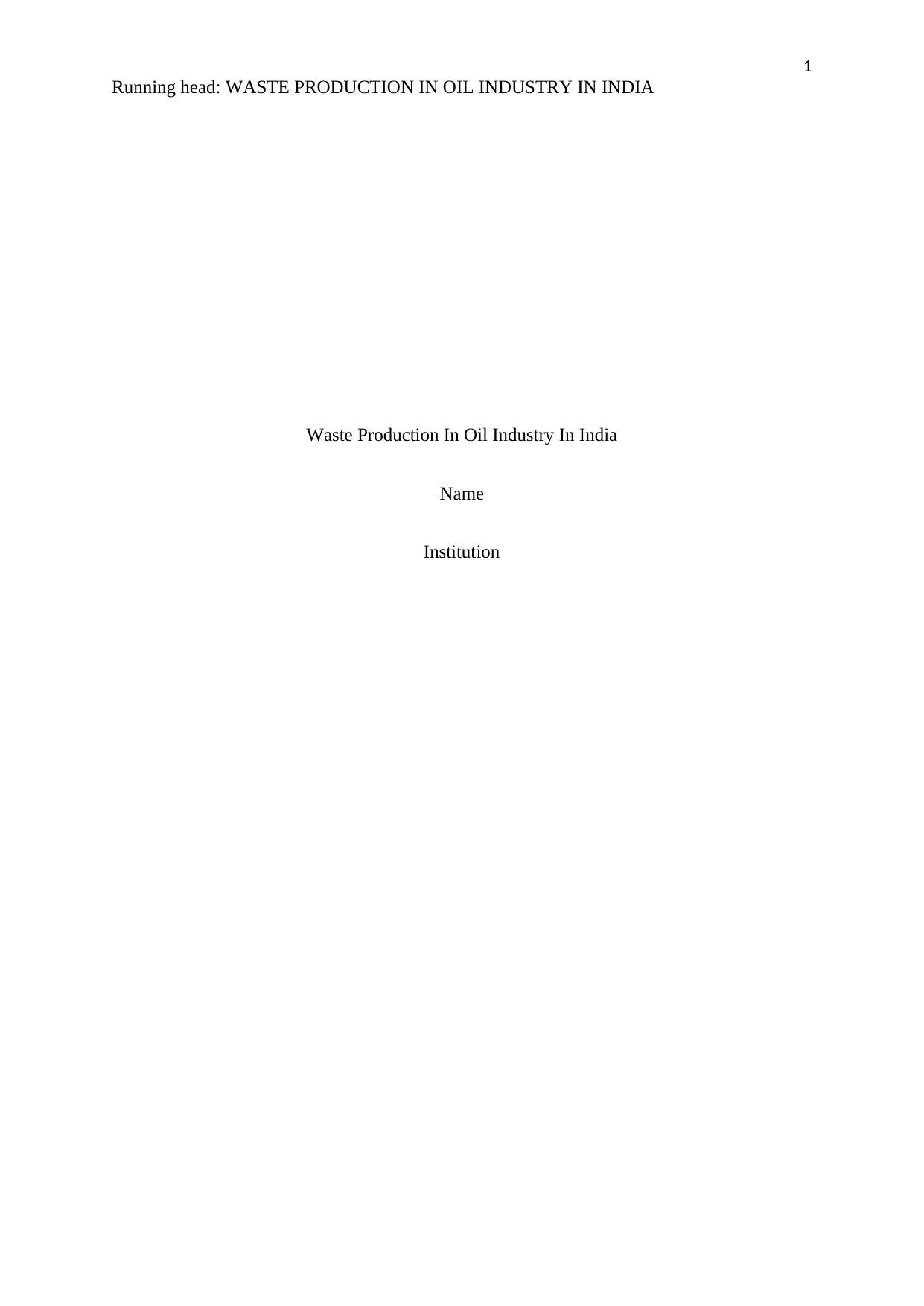
1
Running head: WASTE PRODUCTION IN OIL INDUSTRY IN INDIA
Waste Production In Oil Industry In India
Name
Institution
Running head: WASTE PRODUCTION IN OIL INDUSTRY IN INDIA
Waste Production In Oil Industry In India
Name
Institution
Paraphrase This Document
Need a fresh take? Get an instant paraphrase of this document with our AI Paraphraser
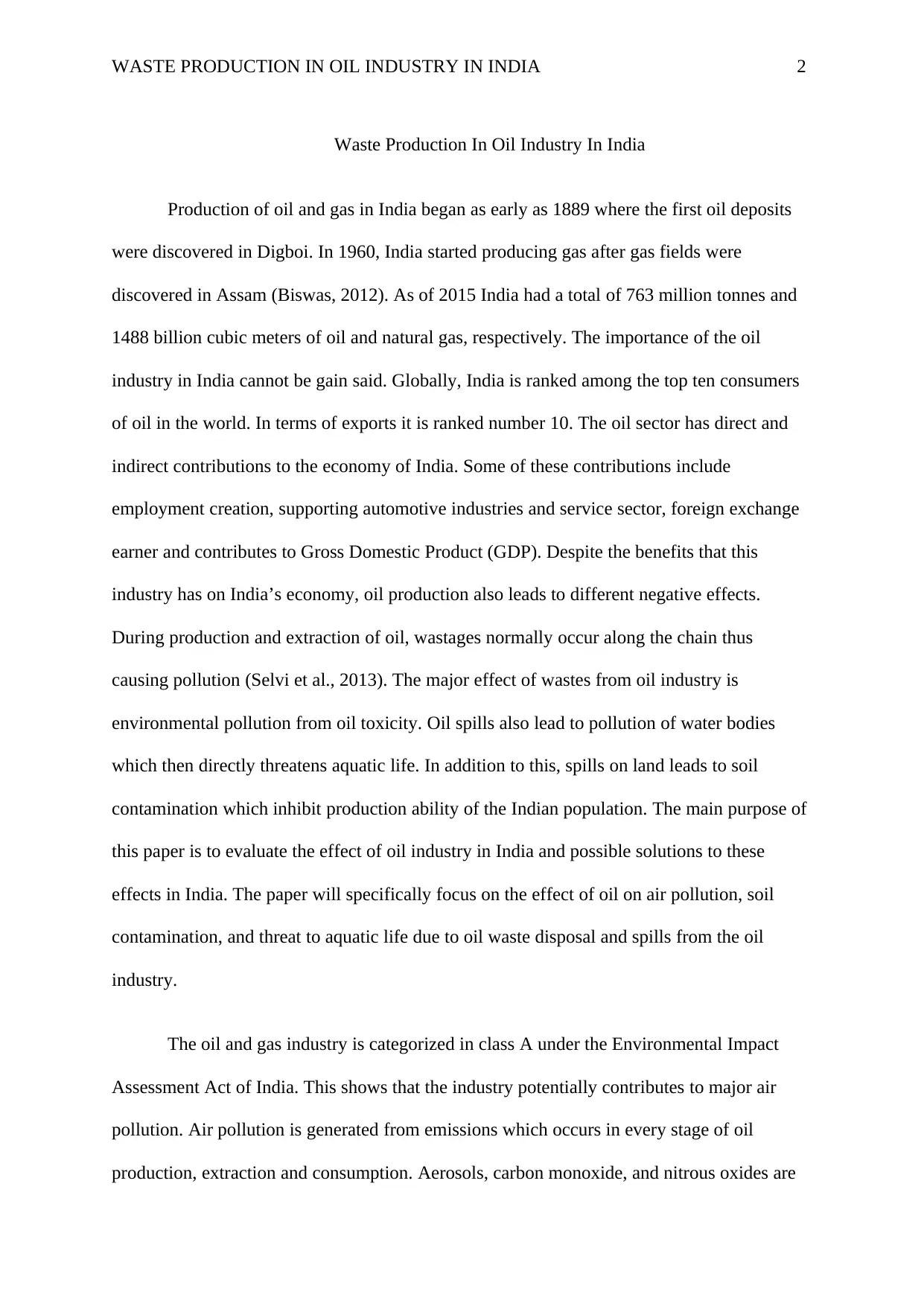
WASTE PRODUCTION IN OIL INDUSTRY IN INDIA 2
Waste Production In Oil Industry In India
Production of oil and gas in India began as early as 1889 where the first oil deposits
were discovered in Digboi. In 1960, India started producing gas after gas fields were
discovered in Assam (Biswas, 2012). As of 2015 India had a total of 763 million tonnes and
1488 billion cubic meters of oil and natural gas, respectively. The importance of the oil
industry in India cannot be gain said. Globally, India is ranked among the top ten consumers
of oil in the world. In terms of exports it is ranked number 10. The oil sector has direct and
indirect contributions to the economy of India. Some of these contributions include
employment creation, supporting automotive industries and service sector, foreign exchange
earner and contributes to Gross Domestic Product (GDP). Despite the benefits that this
industry has on India’s economy, oil production also leads to different negative effects.
During production and extraction of oil, wastages normally occur along the chain thus
causing pollution (Selvi et al., 2013). The major effect of wastes from oil industry is
environmental pollution from oil toxicity. Oil spills also lead to pollution of water bodies
which then directly threatens aquatic life. In addition to this, spills on land leads to soil
contamination which inhibit production ability of the Indian population. The main purpose of
this paper is to evaluate the effect of oil industry in India and possible solutions to these
effects in India. The paper will specifically focus on the effect of oil on air pollution, soil
contamination, and threat to aquatic life due to oil waste disposal and spills from the oil
industry.
The oil and gas industry is categorized in class A under the Environmental Impact
Assessment Act of India. This shows that the industry potentially contributes to major air
pollution. Air pollution is generated from emissions which occurs in every stage of oil
production, extraction and consumption. Aerosols, carbon monoxide, and nitrous oxides are
Waste Production In Oil Industry In India
Production of oil and gas in India began as early as 1889 where the first oil deposits
were discovered in Digboi. In 1960, India started producing gas after gas fields were
discovered in Assam (Biswas, 2012). As of 2015 India had a total of 763 million tonnes and
1488 billion cubic meters of oil and natural gas, respectively. The importance of the oil
industry in India cannot be gain said. Globally, India is ranked among the top ten consumers
of oil in the world. In terms of exports it is ranked number 10. The oil sector has direct and
indirect contributions to the economy of India. Some of these contributions include
employment creation, supporting automotive industries and service sector, foreign exchange
earner and contributes to Gross Domestic Product (GDP). Despite the benefits that this
industry has on India’s economy, oil production also leads to different negative effects.
During production and extraction of oil, wastages normally occur along the chain thus
causing pollution (Selvi et al., 2013). The major effect of wastes from oil industry is
environmental pollution from oil toxicity. Oil spills also lead to pollution of water bodies
which then directly threatens aquatic life. In addition to this, spills on land leads to soil
contamination which inhibit production ability of the Indian population. The main purpose of
this paper is to evaluate the effect of oil industry in India and possible solutions to these
effects in India. The paper will specifically focus on the effect of oil on air pollution, soil
contamination, and threat to aquatic life due to oil waste disposal and spills from the oil
industry.
The oil and gas industry is categorized in class A under the Environmental Impact
Assessment Act of India. This shows that the industry potentially contributes to major air
pollution. Air pollution is generated from emissions which occurs in every stage of oil
production, extraction and consumption. Aerosols, carbon monoxide, and nitrous oxides are
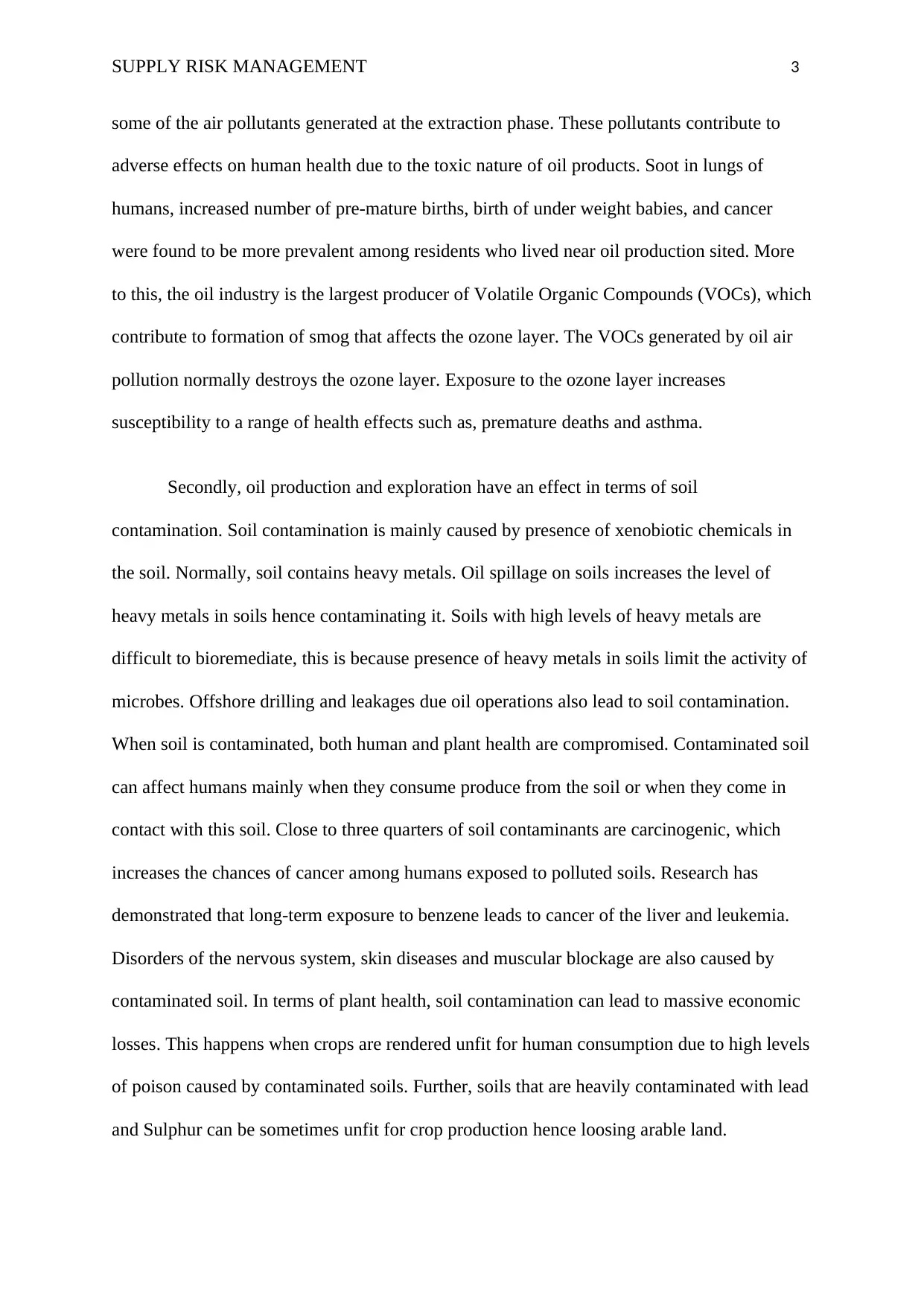
SUPPLY RISK MANAGEMENT 3
some of the air pollutants generated at the extraction phase. These pollutants contribute to
adverse effects on human health due to the toxic nature of oil products. Soot in lungs of
humans, increased number of pre-mature births, birth of under weight babies, and cancer
were found to be more prevalent among residents who lived near oil production sited. More
to this, the oil industry is the largest producer of Volatile Organic Compounds (VOCs), which
contribute to formation of smog that affects the ozone layer. The VOCs generated by oil air
pollution normally destroys the ozone layer. Exposure to the ozone layer increases
susceptibility to a range of health effects such as, premature deaths and asthma.
Secondly, oil production and exploration have an effect in terms of soil
contamination. Soil contamination is mainly caused by presence of xenobiotic chemicals in
the soil. Normally, soil contains heavy metals. Oil spillage on soils increases the level of
heavy metals in soils hence contaminating it. Soils with high levels of heavy metals are
difficult to bioremediate, this is because presence of heavy metals in soils limit the activity of
microbes. Offshore drilling and leakages due oil operations also lead to soil contamination.
When soil is contaminated, both human and plant health are compromised. Contaminated soil
can affect humans mainly when they consume produce from the soil or when they come in
contact with this soil. Close to three quarters of soil contaminants are carcinogenic, which
increases the chances of cancer among humans exposed to polluted soils. Research has
demonstrated that long-term exposure to benzene leads to cancer of the liver and leukemia.
Disorders of the nervous system, skin diseases and muscular blockage are also caused by
contaminated soil. In terms of plant health, soil contamination can lead to massive economic
losses. This happens when crops are rendered unfit for human consumption due to high levels
of poison caused by contaminated soils. Further, soils that are heavily contaminated with lead
and Sulphur can be sometimes unfit for crop production hence loosing arable land.
some of the air pollutants generated at the extraction phase. These pollutants contribute to
adverse effects on human health due to the toxic nature of oil products. Soot in lungs of
humans, increased number of pre-mature births, birth of under weight babies, and cancer
were found to be more prevalent among residents who lived near oil production sited. More
to this, the oil industry is the largest producer of Volatile Organic Compounds (VOCs), which
contribute to formation of smog that affects the ozone layer. The VOCs generated by oil air
pollution normally destroys the ozone layer. Exposure to the ozone layer increases
susceptibility to a range of health effects such as, premature deaths and asthma.
Secondly, oil production and exploration have an effect in terms of soil
contamination. Soil contamination is mainly caused by presence of xenobiotic chemicals in
the soil. Normally, soil contains heavy metals. Oil spillage on soils increases the level of
heavy metals in soils hence contaminating it. Soils with high levels of heavy metals are
difficult to bioremediate, this is because presence of heavy metals in soils limit the activity of
microbes. Offshore drilling and leakages due oil operations also lead to soil contamination.
When soil is contaminated, both human and plant health are compromised. Contaminated soil
can affect humans mainly when they consume produce from the soil or when they come in
contact with this soil. Close to three quarters of soil contaminants are carcinogenic, which
increases the chances of cancer among humans exposed to polluted soils. Research has
demonstrated that long-term exposure to benzene leads to cancer of the liver and leukemia.
Disorders of the nervous system, skin diseases and muscular blockage are also caused by
contaminated soil. In terms of plant health, soil contamination can lead to massive economic
losses. This happens when crops are rendered unfit for human consumption due to high levels
of poison caused by contaminated soils. Further, soils that are heavily contaminated with lead
and Sulphur can be sometimes unfit for crop production hence loosing arable land.
⊘ This is a preview!⊘
Do you want full access?
Subscribe today to unlock all pages.

Trusted by 1+ million students worldwide
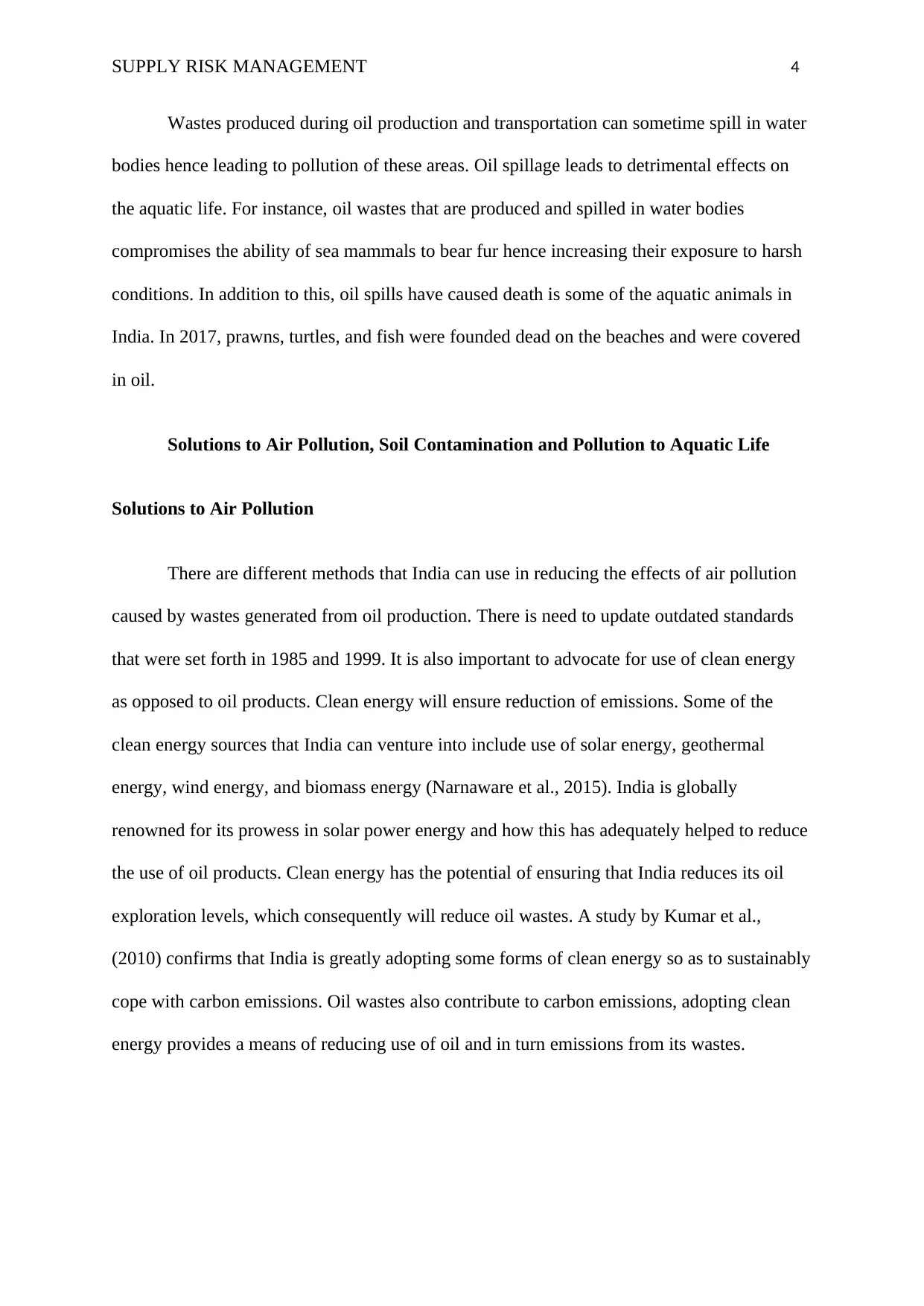
SUPPLY RISK MANAGEMENT 4
Wastes produced during oil production and transportation can sometime spill in water
bodies hence leading to pollution of these areas. Oil spillage leads to detrimental effects on
the aquatic life. For instance, oil wastes that are produced and spilled in water bodies
compromises the ability of sea mammals to bear fur hence increasing their exposure to harsh
conditions. In addition to this, oil spills have caused death is some of the aquatic animals in
India. In 2017, prawns, turtles, and fish were founded dead on the beaches and were covered
in oil.
Solutions to Air Pollution, Soil Contamination and Pollution to Aquatic Life
Solutions to Air Pollution
There are different methods that India can use in reducing the effects of air pollution
caused by wastes generated from oil production. There is need to update outdated standards
that were set forth in 1985 and 1999. It is also important to advocate for use of clean energy
as opposed to oil products. Clean energy will ensure reduction of emissions. Some of the
clean energy sources that India can venture into include use of solar energy, geothermal
energy, wind energy, and biomass energy (Narnaware et al., 2015). India is globally
renowned for its prowess in solar power energy and how this has adequately helped to reduce
the use of oil products. Clean energy has the potential of ensuring that India reduces its oil
exploration levels, which consequently will reduce oil wastes. A study by Kumar et al.,
(2010) confirms that India is greatly adopting some forms of clean energy so as to sustainably
cope with carbon emissions. Oil wastes also contribute to carbon emissions, adopting clean
energy provides a means of reducing use of oil and in turn emissions from its wastes.
Wastes produced during oil production and transportation can sometime spill in water
bodies hence leading to pollution of these areas. Oil spillage leads to detrimental effects on
the aquatic life. For instance, oil wastes that are produced and spilled in water bodies
compromises the ability of sea mammals to bear fur hence increasing their exposure to harsh
conditions. In addition to this, oil spills have caused death is some of the aquatic animals in
India. In 2017, prawns, turtles, and fish were founded dead on the beaches and were covered
in oil.
Solutions to Air Pollution, Soil Contamination and Pollution to Aquatic Life
Solutions to Air Pollution
There are different methods that India can use in reducing the effects of air pollution
caused by wastes generated from oil production. There is need to update outdated standards
that were set forth in 1985 and 1999. It is also important to advocate for use of clean energy
as opposed to oil products. Clean energy will ensure reduction of emissions. Some of the
clean energy sources that India can venture into include use of solar energy, geothermal
energy, wind energy, and biomass energy (Narnaware et al., 2015). India is globally
renowned for its prowess in solar power energy and how this has adequately helped to reduce
the use of oil products. Clean energy has the potential of ensuring that India reduces its oil
exploration levels, which consequently will reduce oil wastes. A study by Kumar et al.,
(2010) confirms that India is greatly adopting some forms of clean energy so as to sustainably
cope with carbon emissions. Oil wastes also contribute to carbon emissions, adopting clean
energy provides a means of reducing use of oil and in turn emissions from its wastes.
Paraphrase This Document
Need a fresh take? Get an instant paraphrase of this document with our AI Paraphraser

SUPPLY RISK MANAGEMENT 5
Solutions to Aquatic pollution
Contaminated soil and water pose a potential threat to both human, plant and aquatic
life. Contamination caused by wastage in oil production in India can be controlled by,
application of the polluters pay principle whereby firms that are involved in oil exploration in
India commit to paying for clean-up programs in water bodies. Normally, these funds that are
collected from this firms can be used in purchasing dispersants, biosurfactants, absorbent
socks and pads, and emulsifiers. These approaches are renowned for their ability to control
for oil spills in the water bodies. For instance, biosurfactants help in breaking the link
between oil and water so as to allow air to pass through and reach the aquatic organisms
Solutions to Soil Contamination
Contaminated soil can be controlled using both in-situ and ex-situ techniques. In-situ
methods such as, air sparging and ignition can be used. Ex-situ applications are normally
applicable where low volumes of soil are involved. This method involves transportation of
contaminated soils to remediation centers. Bioremediation treatment is the current method
that is globally used in correcting for soil contamination (Abha & Singh, 2012). This method
uses the biological ability of microorganisms to act on the toxicity of pollutants and convert
them to less harmful metabolites. One method of bioremediation that is applied to neutralize
the effect of soil contaminants is addition on nitrate and/or sulphate fertilizers to the soil
(Mandal et al., 2011). India can adequately apply this method by applying nitrate and
sulphate fertilizers on contaminated soils so as to rehabilitate them.
Solutions to Aquatic pollution
Contaminated soil and water pose a potential threat to both human, plant and aquatic
life. Contamination caused by wastage in oil production in India can be controlled by,
application of the polluters pay principle whereby firms that are involved in oil exploration in
India commit to paying for clean-up programs in water bodies. Normally, these funds that are
collected from this firms can be used in purchasing dispersants, biosurfactants, absorbent
socks and pads, and emulsifiers. These approaches are renowned for their ability to control
for oil spills in the water bodies. For instance, biosurfactants help in breaking the link
between oil and water so as to allow air to pass through and reach the aquatic organisms
Solutions to Soil Contamination
Contaminated soil can be controlled using both in-situ and ex-situ techniques. In-situ
methods such as, air sparging and ignition can be used. Ex-situ applications are normally
applicable where low volumes of soil are involved. This method involves transportation of
contaminated soils to remediation centers. Bioremediation treatment is the current method
that is globally used in correcting for soil contamination (Abha & Singh, 2012). This method
uses the biological ability of microorganisms to act on the toxicity of pollutants and convert
them to less harmful metabolites. One method of bioremediation that is applied to neutralize
the effect of soil contaminants is addition on nitrate and/or sulphate fertilizers to the soil
(Mandal et al., 2011). India can adequately apply this method by applying nitrate and
sulphate fertilizers on contaminated soils so as to rehabilitate them.
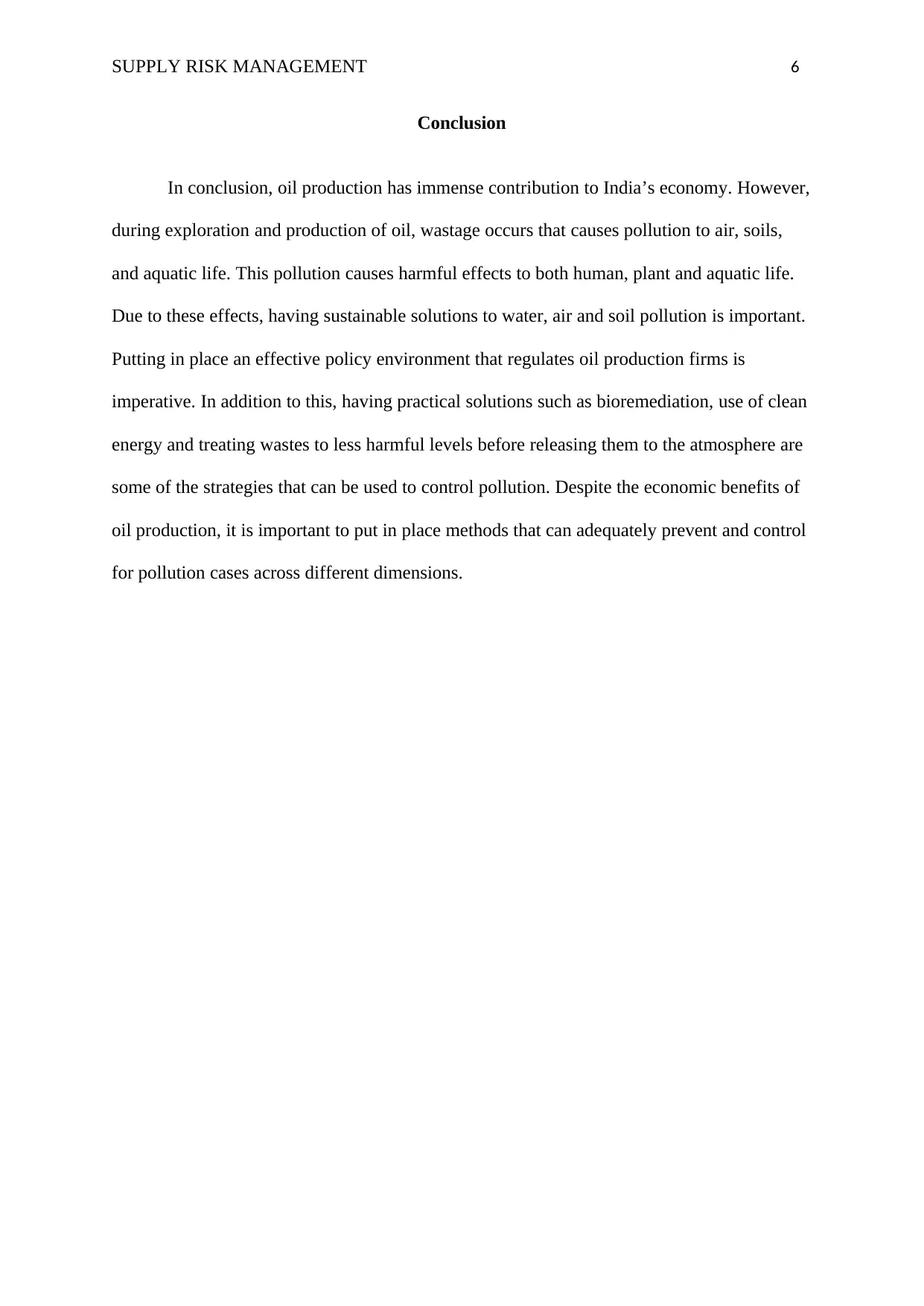
SUPPLY RISK MANAGEMENT 6
Conclusion
In conclusion, oil production has immense contribution to India’s economy. However,
during exploration and production of oil, wastage occurs that causes pollution to air, soils,
and aquatic life. This pollution causes harmful effects to both human, plant and aquatic life.
Due to these effects, having sustainable solutions to water, air and soil pollution is important.
Putting in place an effective policy environment that regulates oil production firms is
imperative. In addition to this, having practical solutions such as bioremediation, use of clean
energy and treating wastes to less harmful levels before releasing them to the atmosphere are
some of the strategies that can be used to control pollution. Despite the economic benefits of
oil production, it is important to put in place methods that can adequately prevent and control
for pollution cases across different dimensions.
Conclusion
In conclusion, oil production has immense contribution to India’s economy. However,
during exploration and production of oil, wastage occurs that causes pollution to air, soils,
and aquatic life. This pollution causes harmful effects to both human, plant and aquatic life.
Due to these effects, having sustainable solutions to water, air and soil pollution is important.
Putting in place an effective policy environment that regulates oil production firms is
imperative. In addition to this, having practical solutions such as bioremediation, use of clean
energy and treating wastes to less harmful levels before releasing them to the atmosphere are
some of the strategies that can be used to control pollution. Despite the economic benefits of
oil production, it is important to put in place methods that can adequately prevent and control
for pollution cases across different dimensions.
⊘ This is a preview!⊘
Do you want full access?
Subscribe today to unlock all pages.

Trusted by 1+ million students worldwide
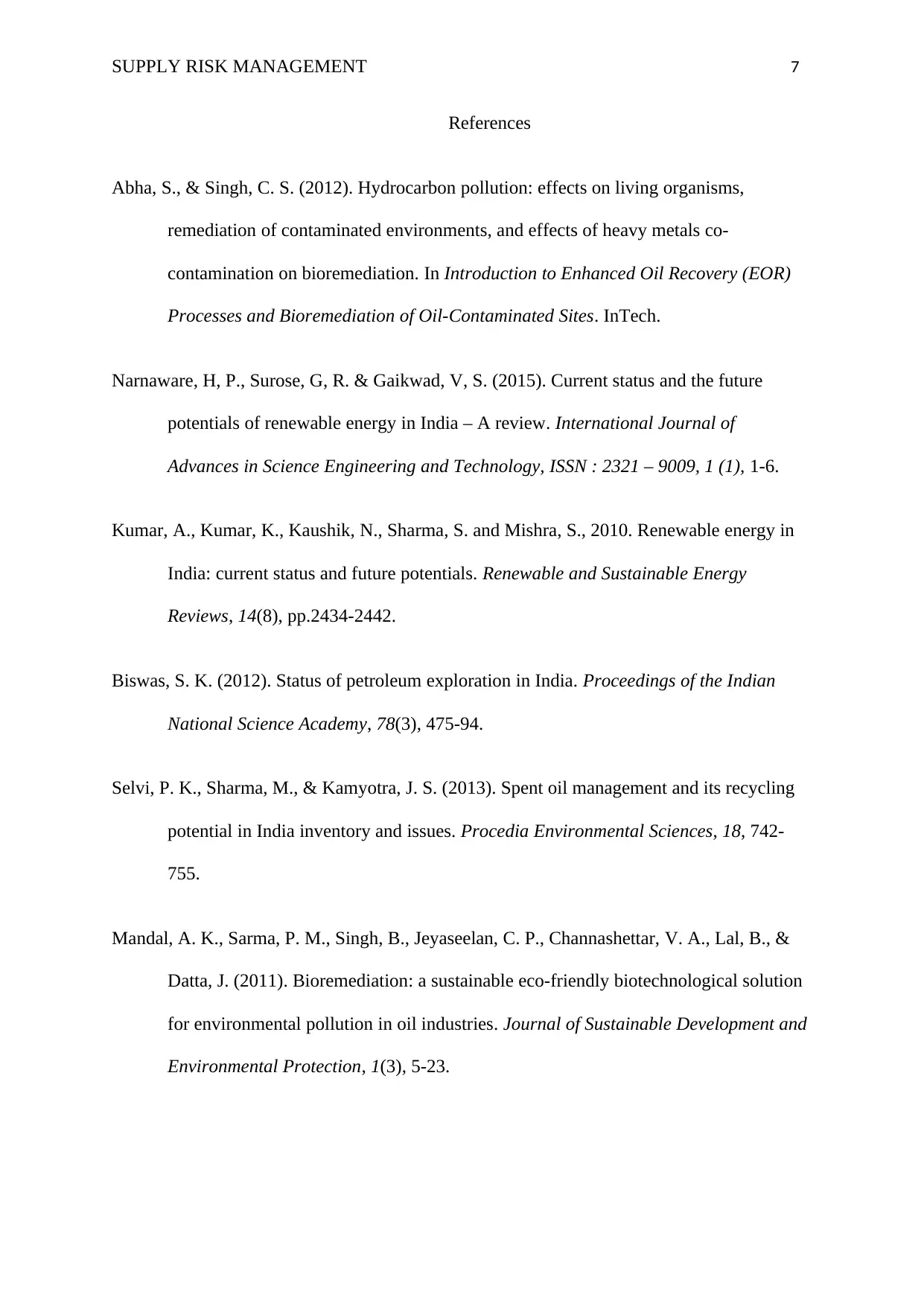
SUPPLY RISK MANAGEMENT 7
References
Abha, S., & Singh, C. S. (2012). Hydrocarbon pollution: effects on living organisms,
remediation of contaminated environments, and effects of heavy metals co-
contamination on bioremediation. In Introduction to Enhanced Oil Recovery (EOR)
Processes and Bioremediation of Oil-Contaminated Sites. InTech.
Narnaware, H, P., Surose, G, R. & Gaikwad, V, S. (2015). Current status and the future
potentials of renewable energy in India – A review. International Journal of
Advances in Science Engineering and Technology, ISSN : 2321 – 9009, 1 (1), 1-6.
Kumar, A., Kumar, K., Kaushik, N., Sharma, S. and Mishra, S., 2010. Renewable energy in
India: current status and future potentials. Renewable and Sustainable Energy
Reviews, 14(8), pp.2434-2442.
Biswas, S. K. (2012). Status of petroleum exploration in India. Proceedings of the Indian
National Science Academy, 78(3), 475-94.
Selvi, P. K., Sharma, M., & Kamyotra, J. S. (2013). Spent oil management and its recycling
potential in India inventory and issues. Procedia Environmental Sciences, 18, 742-
755.
Mandal, A. K., Sarma, P. M., Singh, B., Jeyaseelan, C. P., Channashettar, V. A., Lal, B., &
Datta, J. (2011). Bioremediation: a sustainable eco-friendly biotechnological solution
for environmental pollution in oil industries. Journal of Sustainable Development and
Environmental Protection, 1(3), 5-23.
References
Abha, S., & Singh, C. S. (2012). Hydrocarbon pollution: effects on living organisms,
remediation of contaminated environments, and effects of heavy metals co-
contamination on bioremediation. In Introduction to Enhanced Oil Recovery (EOR)
Processes and Bioremediation of Oil-Contaminated Sites. InTech.
Narnaware, H, P., Surose, G, R. & Gaikwad, V, S. (2015). Current status and the future
potentials of renewable energy in India – A review. International Journal of
Advances in Science Engineering and Technology, ISSN : 2321 – 9009, 1 (1), 1-6.
Kumar, A., Kumar, K., Kaushik, N., Sharma, S. and Mishra, S., 2010. Renewable energy in
India: current status and future potentials. Renewable and Sustainable Energy
Reviews, 14(8), pp.2434-2442.
Biswas, S. K. (2012). Status of petroleum exploration in India. Proceedings of the Indian
National Science Academy, 78(3), 475-94.
Selvi, P. K., Sharma, M., & Kamyotra, J. S. (2013). Spent oil management and its recycling
potential in India inventory and issues. Procedia Environmental Sciences, 18, 742-
755.
Mandal, A. K., Sarma, P. M., Singh, B., Jeyaseelan, C. P., Channashettar, V. A., Lal, B., &
Datta, J. (2011). Bioremediation: a sustainable eco-friendly biotechnological solution
for environmental pollution in oil industries. Journal of Sustainable Development and
Environmental Protection, 1(3), 5-23.
1 out of 7
Related Documents
Your All-in-One AI-Powered Toolkit for Academic Success.
+13062052269
info@desklib.com
Available 24*7 on WhatsApp / Email
![[object Object]](/_next/static/media/star-bottom.7253800d.svg)
Unlock your academic potential
Copyright © 2020–2025 A2Z Services. All Rights Reserved. Developed and managed by ZUCOL.





